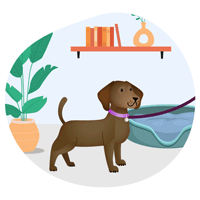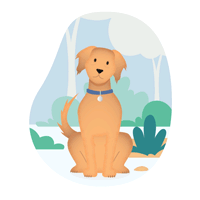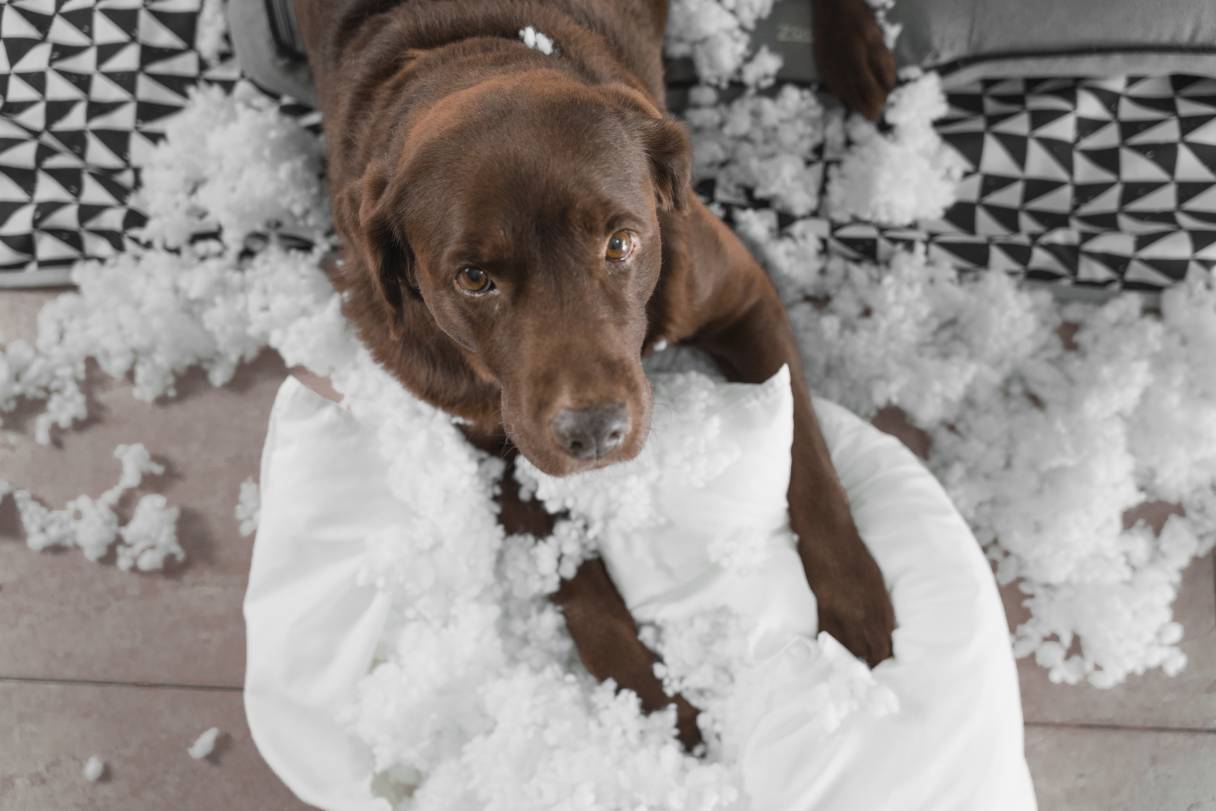Whether you’re bringing home a new puppy or working with an adult dog, there’s no wrong time to start training. Puppies may be able to begin short sessions as soon as they leave their mother at eight weeks, depending on vaccinations. Whatever your dog’s age, early training lays the foundation for good behavior, clear communication and a strong, trusting bond. Here are a few tips to help you get started training your dog.
7 Tips for Success When Training Your Dog
Training may be most effective when you set your dog up for success. The following tips may help you keep sessions effective and positive so your pup can learn new skills while staying engaged.
1. Keep training sessions short
This might mean starting with just a couple of repetitions and no longer than five-minute training session. Work your way up to more complex training cues and situations.1
2. Celebrate improvement
Dogs are smart, but it can still take them time to learn new skills. Some will pick things up more quickly than others — try not to get frustrated with them as they learn, and celebrate the small wins as they improve.1
3. Be a vending machine
Think of it this way: When you first start training your puppy or dog, you are a vending machine. Every time they do what you ask, they get a reward. When they do what you ask eight to 10 times out of 10, you can become a slot machine and reward them randomly.2
Don’t eliminate the reward altogether, or your smart pup may decide it’s not worth it to listen. The random rewards may keep them trying because they never know which time they’ll get rewarded.2
4. Practice in different environments

You probably already know that puppies may be easily distracted, but older dogs can be, too. Start training sessions in the least distracting environment possible, like a quiet room in your house, and build up to more distracting environments. When your puppy or dog can reliably follow your commands inside, move outside, and then to the front of your house or apartment.1
5. Try training before mealtimes
If your dog is food motivated, training them with either kibble or treats before a meal may help keep their attention. You can also use mealtime as an opportunity for training. For example, ask your dog to sit and/or stay until you give them their food bowl.3
6. Stay consistent
Consistency can be key, so ensure other members of your household follow the same protocol around your puppy or dog, use the same words, have the same expectations, etc.1
7. Be prepared
Pick up special, high-value treats that are just for training, as well as a treat bag, which may be helpful if you need somewhere to store treats while walking and training out in the world.4
Don’t forget your clicker (if you are doing the clicker training described below).5
What Is Positive Reinforcement Training?
Positive reinforcement training is a method that uses a reward for desired behaviors, making it a highly effective way to train your dog.6
Using positive reinforcement to train your puppy or dog doesn’t necessarily mean treat training. It means rewarding the behaviors you want your dog to do more of.4
When you train your dog to be rewarded for doing something right instead of being punished when they do something wrong, they are more likely to enjoy training, gain confidence and — perhaps most importantly — build a strong bond with you and other family members.6
If your dog is highly food motivated, that will likely mean treats. Other dogs may be more motivated by their favorite toy or attention from their favorite person. Figure out what your dog is willing to work for and use that during training sessions.4
If my dog sits in front of me and I pet them, praise them, and reward them with a treat, the chances are, they'll do it again.
Antonio Diaz
Professional Dog Trainer


Food motivation
For food-motivated dogs, use small treats that they can eat quickly. Treats should be enticing and irresistible, and it’s helpful to experiment to see which ones your pup likes best. Keeping a variety on hand can also prevent them from getting bored with the same reward every time.4
Clicker training
Clicker training is an aspect of positive reinforcement training that uses a small mechanical noisemaker to tell your dog the behavior that you are rewarding and would like to see more of. You click at the moment your dog does what you want. When training your dog to sit, for example, you could click as soon as the dog’s bottom touches the ground.5 In a pinch, a click pen could do the trick.
Basic Dog Training Overview
Some common dog training lessons might include:
- Coming when called
- Leash training
- Sitting
- Fetching
- Stopping barking
Here’s a brief look at each of them.
Teaching a dog to come when called
Teaching your dog to come on command can be a lifesaver if they dash out the front door or run off while you’re at the park.7
Start in the least distracting environment you can find (like your living room), and start very close to your dog. Decide if you will use “here” or “come,” and then use a cheerful voice to say their name plus the command while you are close to them. Make noises, squeak their toy and do whatever it takes to get their attention and interest. When they get to you, throw a puppy party and act like they’re the best thing in the world.7 (If your pup seems nervous by all the attention, you may not want to go overboard.)
Most importantly, avoid sounding angry or harsh if it takes them a while to make their way to you. You want them to associate coming to you with good things, not bad consequences. As your puppy or dog gets better at this, you can place a squeaky toy between you and your dog as a distraction or have another family member stand nearby.7
Once you get outside, you can practice using a long line (a leash that’s 20 feet or longer). If your dog doesn’t come, use the leash to walk yourself to them — don’t use it to pull them to you.7
Leash training a dog
Leash training, or loose-leash walking, is a skill that can help make walks more enjoyable and potentially safer for you and your dog.8
When you’re ready for walking, keep the leash loose. Using a regular flat leash with a harness vs. a retractable leash and any other kind of collar can be advantageous. The flat leash and harness are easy to control and give your dog a predictable amount of distance to go — a retractable leash with different lengths can make leash training confusing. A flat leash and harness are sturdy and safe and allow you to control your dog much more quickly and easily.8 (Tip: If your dog pulls hard with a harness, get one that clips in the front for more control.)
There are two different methods for teaching loose-leash walking that work well:8
- Method 1. As soon as your dog begins to pull, stop and wait for them to stop pulling until you walk again. You don’t have to jerk the leash — just wait for them to figure it out on their own. The reward is to continue walking when they bring their attention back to you.
- Method 2. Use treats to encourage your dog to stay by your side and reward them every few steps. You can also use a treat to get their attention if they start to get distracted or reward them for coming back to you.
You can also add the command “heel” when your dog is walking next to you or say it as they’re coming back to you.8 You may want to teach your dog “ok” or “go ahead” when they’re allowed to go sniff something instead of staying right next to you. Gradually extend the number of steps between treats and watch their progress.8
Teaching a dog to sit
Teaching your dog to sit can be helpful in a variety of situations, which is why it is one of the first commands we teach our dogs.9
Here’s how you do it:9

- With your dog standing in front of you, hold a treat in front of their nose.
- Keep the object right in front of their nose and slowly take it up and over their head. As your dog looks up, they are likely to sit. Resist the urge to push on their lower back or bottom. Remember: We want the dog to learn to do it on their own.
- When they get the hang of it, start saying “sit” as you move your hand up to pair the command with the action.
Teaching a dog to play fetch
Some dogs may be bred to fetch, and others are not. Yet any breed can learn how to play a good old-fashioned game of fetch.
Your dog may pick it up naturally, but if you want to push things along, follow these steps:10
- Start by teaching your dog to hold a toy and reward them for showing interest and picking it up.
- Once they can reliably hold the toy, place it on the ground and ask them to pick it up.
- Gradually increase the distance you place the toy, then begin tossing it a short distance and encourage your dog to retrieve it.
- Reward each successful retrieve and repeat.
Training a dog to stop barking
Dogs bark for several primary reasons: to alert you about something, to be territorial, to get your attention or because they’re anxious or excited.11 If you’re looking to cut down on the yips and yaps, you have some options, depending on the root cause.
- Alert barking. If someone is at the door or walking by, and you want your dog to bark a few times and then stop, you can teach them “quiet” on command. Practice by having someone knock at the door so you can show them a toy or treat and tell them “enough” or “quiet.” When they stop, reward them.11
- Attention or excitement barking. If your puppy or dog barks for food or to play, ignore them — and then reward them when they quiet down. Be sure not to give any attention while they are barking.11
- Boredom barking. Many dogs bark for attention when they’re lonely or bored. Make sure your pet is getting enough exercise and mental stimulation and don't leave them unattended in the yard.12
- Fear or territorial barking. This type of barking is often motivated by fear or by wanting to guard territory. Limiting your dog’s exposure to the sights and sounds that trigger barking, or calmly moving them away from the situation, can help.11
When to Consider Professional Help With Dog Training
Even the most patient and consistent dog owners need extra support sometimes. If your dog shows signs like persistent aggression, anxiety or destructive behavior or if they simply aren’t progressing with basic training, you may want to consider bringing in a professional.
Depending on the issue, you have different options:13
- Certified behaviorists. These specialists may be best for complex issues, such as fear, reactivity or aggression, since they have advanced training in animal behavior.
- Group classes. Often led by certified trainers, these classes can offer structure and socialization, making them a great choice for puppies or dogs who need practice around distractions.
- Private sessions. These involve one-on-one guidance with a trainer and are tailored to your dog’s specific challenges and your household routine. The sessions may be held at your home or at the trainer’s facility, if they have one.
- Board-and-train. This method is when you leave your dog at the trainer's facility for a certain amount of time and they train your dog for you. Be sure that you agree with their methods, are able to see where your dog will be staying, and that they provide training to you when you bring your pup back home.
When choosing a trainer, look for credentials (such as CPDT-KA certification), positive reinforcement methods and a style that feels comfortable for both you and your dog.13
Building a Lifelong Bond
Training your dog is more than just teaching commands — it’s about building trust, communication and a lasting bond. Whether you start with simple lessons at home, move into more advanced skills or seek guidance from a professional, every bit of effort you put in now can help set the stage for a happier, well-behaved companion who thrives alongside you for years to come.
CareCredit Credit Card Financing for Dogs
The CareCredit credit card provides a convenient way to pay for your dog’s vaccinations and other health and wellness expenses, including exams, medications and products at providers in the CareCredit network.* Continue your wellness journey by downloading the CareCredit Mobile App. You can find a provider on the go, manage your CareCredit account and easily access the Well U blog for more great articles, podcasts and videos. Use our Acceptance Locator to find a veterinarian that accepts CareCredit to help keep your pet healthy and happy for a lifetime of love.
In addition to pet care, you can also use your CareCredit credit card for dentistry, cosmetic, vision, hearing, health systems, dermatology, pharmacy purchases, spa treatments and so much more within the CareCredit network. How will you invest in your health and wellness next?
Featured Video Expert Bio
Antonio Diaz, founder of Leader of the Pack K9 Training, is a professional dog trainer and behavior expert with more than a decade of experience in rewards-based balanced training and behavior rehabilitation. Known for his clear communication and ability to simplify complex behavioral concepts, he helps owners develop well-mannered dogs through relationship-based leadership. As director of education for the International Association of Canine Professionals, Antonio helps shape industry standards, professional development and ethical training practices. He also creates online courses and serves as a canine subject matter expert for CareCredit.
Author Bio
Abbie Mood is a freelance writer with more than 15 years of experience. She has worked with clients of all sizes to create compelling content and she has written for the American Kennel Club, Marriott Bonvoy, Women’s Health Online, Headspace and more.









